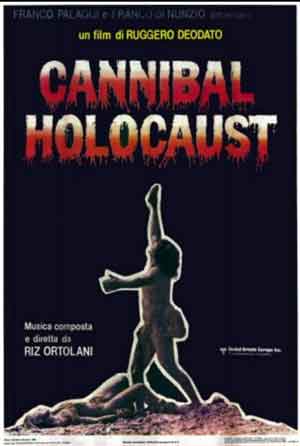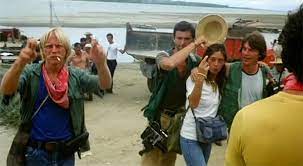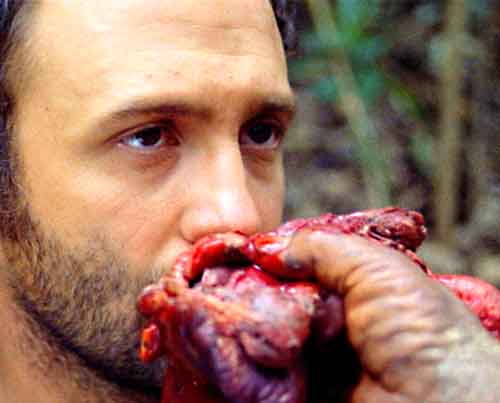 CANNIBAL HOLOCAUST, this hugely controversial exploitation epic, is easily the best of the Italian cannibal movies of the late seventies and early eighties. It’s also one of the most repellant, disturbing and morally repugnant films ever made. To use an outmoded but entirely appropriate cliché: You have been warned!
CANNIBAL HOLOCAUST, this hugely controversial exploitation epic, is easily the best of the Italian cannibal movies of the late seventies and early eighties. It’s also one of the most repellant, disturbing and morally repugnant films ever made. To use an outmoded but entirely appropriate cliché: You have been warned!
You have been warned!
CANNIBAL HOLOCAUST marked the start of the Italian cannibal-exploitation movie cycle, even though it wasn’t the first such film. That distinction is usually accorded to Umberto Lenzi’s THE MAN FROM DEEP RIVER (1972), which was followed by Ruggero Deodato’s JUNGLE HOLOCAUST (1977). That film is now viewed as a sort of dry run for the seminal CANNIBAL HOLOCAUST, directed by Deodato and sporadically released in 1980.
Unsurprisingly, it was heavily banned and led Deodato into a three-year court battle based on entirely justifiable charges of animal cruelty. Animal cruelty is something the film contains in abundance. It’s an element of all the subsequent cannibal movies (about which I understand the famed graphic artist/film critic Steven R. Bissette has reportedly written an entire book). They include EMERALD JUNGLE (1980), CANNIBAL FEROX (1981) and MASSACRE IN DINOSAUR VALLEY (1985). All replicate CANNIBAL HOLOCAUST’S premise: white people traipse into the Amazon, terrorize the “savage” inhabitants and eventually become the main course in a cannibal banquet. But none of those subsequent programmers contain a shade of the gut level nastiness or filmmaking savvy of Deodato’s film, which anticipated the mock documentary format popular in modern indies with its film-within-a-film framework. That latter aspect, incidentally, was used in THE BLAIR WITCH PROJECT, although its makers strenuously deny any connection (right!).
Animal cruelty is something the film contains in abundance.
In the end such an accomplishment, vile though it may be, will always be a rarity. There’s never been another film quite like CANNIBAL HOLOCAUST, despite the attempts of so many filmmakers to imitate it, and nor has Deodato ever been able to recapture its power. His subsequent efforts include the limp slasher flicks BODY COUNT (1987) and DIAL: HELP (1988), and the jungle adventure CUT AND RUN (1985), which outside some potent grue has little worth recommending. CANNIBAL HOLOCAUST is almost certainly his masterpiece, although I’m fully aware that “masterpiece” is an entirely subjective term when applied to a movie like this.
…CANNIBAL HOLOCAUST is almost certainly his masterpiece, although I’m fully aware that “masterpiece” is an entirely subjective term when applied to a movie like this.
The esteemed Professor Monroe is investigating the disappearance of a documentary film crew in the wilds of the Amazon. Monroe flies into the “Green Inferno” with his own crew, to the area the missing filmmakers were exploring. There they happen upon the People of the Trees, a cannibal tribe whose activities include sticking a spiked mudball up a woman’s vagina as punishment for adultery. One of Monroe’s crewmembers disembowels a muskrat and feeds its ripped-out stomach to an Amazon they’ve taken captive, but this does nothing to endear Monroe or his companions to the natives. Eventually Monroe elects to strip naked, which goes a long way toward improving relations with the cannibals. They direct him to four stripped-clean skeletons that once housed the brains, innards and skin of the missing film crew, and hand over the film they shot.
 Back in New York Monroe screens the exposed film, which has been pieced together by an editor. The footage, scratched-up and grainy, shows the four filmmakers—three men and a woman—loose in the same Amazon locations Monroe investigated. There they sadistically rip apart a turtle so they can feast on its innards and torment the native inhabitants by burning down their village (and having sex in the embers). They also stage a makeshift abortion in which a pregnant woman is tied spread-eagled, has her child ripped from her womb and then is beaten to death. And that’s not all: the three male filmmakers gang rape a native woman in a mud pit and happen upon the corpse of a woman (the same?) impaled by a long stake stuck through her vagina and out her mouth. After this the Tree People invade, and the intrepid moviemakers meet their collective end in an all-out cannibal chowdown with all the trimmings: scalping, head lopping, penis whacking and intestine pulling.
Back in New York Monroe screens the exposed film, which has been pieced together by an editor. The footage, scratched-up and grainy, shows the four filmmakers—three men and a woman—loose in the same Amazon locations Monroe investigated. There they sadistically rip apart a turtle so they can feast on its innards and torment the native inhabitants by burning down their village (and having sex in the embers). They also stage a makeshift abortion in which a pregnant woman is tied spread-eagled, has her child ripped from her womb and then is beaten to death. And that’s not all: the three male filmmakers gang rape a native woman in a mud pit and happen upon the corpse of a woman (the same?) impaled by a long stake stuck through her vagina and out her mouth. After this the Tree People invade, and the intrepid moviemakers meet their collective end in an all-out cannibal chowdown with all the trimmings: scalping, head lopping, penis whacking and intestine pulling.
There the footage ends. Professor Monroe orders the film burned and leaves with the pointed query, “I wonder who the real cannibals are?”
You might object to CANNIBAL HOLOCAUST on moral grounds (and it does contain more than its share of objections in that area), but it was undeniably made with great skill. The faux documentary contained within the film was fashioned long before the mock-doc format became popular (in CLOVERFIELD, DIARY OF THE DEAD and the above-mentioned BLAIR WITCH PROJECT), and is ingeniously carried off by Ruggero Deodato, who includes manufactured scratches, lens flares, snatches of blank film and a sense of brutal realism worthy of the Italian neorealist classics of Roberto Rossellini, for whom Deodato worked as an assistant for many years. (The only drawbacks are the tacky music cues—the dramatic rationalization for their presence, that the onscreen editor overlaid the rough documentary footage with “stock music”, is a lame one). It all builds to an unforgettable crescendo of insanity and mutilation that will impact even the most hardened viewers.
There’s lots of grue on display, but in keeping with Deodato’s staunch reality-based aesthetic, none of it is ever pleasurable in the least bit, even for an admitted gorehound like myself. Indeed, the bloodletting is downright unpleasant, particularly in the real-life animal mutilations, which rival those of the “Mondo” shockumentaries of the sixties for sheer vileness.
There’s lots of grue on display, but in keeping with Deodato’s staunch reality-based aesthetic, none of it is ever pleasurable…
Deodato’s aim here, despite seemingly lofty intentions, was first and foremost to shock. CANNIBAL HOLOCAUST is unadulterated exploitation above all else, and one of the most potent such films ever made—it is truly, as the Grindhouse Releasing DVD cover proclaims, “The One That Goes All The Way”.
Vital Statistics
CANNIBAL HOLOCAUST
F.D. Cinematografica/Grindhouse Releasing
Director: Ruggero Deodato
Producers: Franco Di Nunzio, Franco Palaggi
Screenplay: Gianfranco Clerici
Cinematography: Sergio D’Offizi
Editing: Vincenzo Tomassi
Cast: Robert Kerman, Francesca Ciardi, Perry Pirkanen, Luca Barbareschi, Salvatore Basile, Ricardo Fuentes, Carl Gabriel Yorke, Paolo Paoloni, Lionello Pio Di Savoia, Luigina Rocchi, Lucia Costantini, Ruggero Deodato, Enrico Papa
